-
Product Name
ATP11C Polyclonal Antibody
- Documents
-
Description
Polyclonal antibody to ATP11C
-
Tested applications
WB
-
Species reactivity
Human, Mouse
-
Alternative names
ATP11C antibody; ATPIG antibody; ATPIQ antibody; phospholipid-transporting ATPase IG antibody
-
Isotype
Rabbit IgG
-
Preparation
Antigen: Recombinant fusion protein containing a sequence corresponding to amino acids 430-650 of human ATP11C (NP_775965.2).
-
Clonality
Polyclonal
-
Formulation
PBS with 0.02% sodium azide, 50% glycerol, pH7.3.
-
Storage instructions
Store at -20℃. Avoid freeze / thaw cycles.
-
Applications
WB 1:500 - 1:2000
-
Validations

Western blot - ATP11C Polyclonal Antibody
Western blot analysis of extracts of various cell lines, using ATP11C antibody at 1:1000 dilution.Secondary antibody: HRP Goat Anti-Rabbit IgG (H+L) at 1:10000 dilution.Lysates/proteins: 25ug per lane.Blocking buffer: 3% nonfat dry milk in TBST.Detection: ECL Basic Kit .Exposure time: 5s.
-
Background
Catalytic component of a P4-ATPase flippase complex which catalyzes the hydrolysis of ATP coupled to the transport of aminophospholipids from the outer to the inner leaflet of various membranes and ensures the maintenance of asymmetric distribution of phospholipids. In the cell membrane of erythrocytes, it is required to maintain phosphatidylserine (PS) in the inner leaflet preventing its exposure on the surface. This asymmetric distribution is critical for the survival of erythrocytes in circulation since externalized PS is a phagocytic signal for splenic macrophages. Phospholipid translocation seems also to be implicated in vesicle formation and in uptake of lipid signaling molecules (By similarity). Required for B cell differentiation past the pro-B cell stage (By similarity). Seems to mediate PS flipping in pro-B cells (By similarity). May be involved in the transport of cholestatic bile acids (By similarity).
Related Products / Services
Please note: All products are "FOR RESEARCH USE ONLY AND ARE NOT INTENDED FOR DIAGNOSTIC OR THERAPEUTIC USE"
